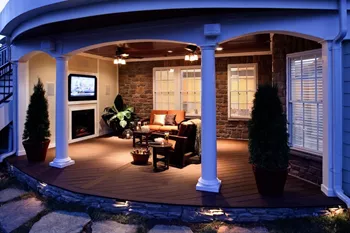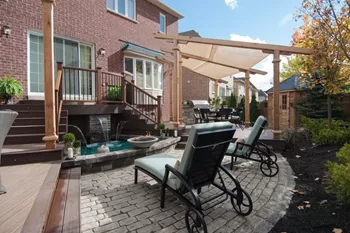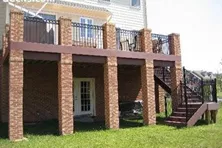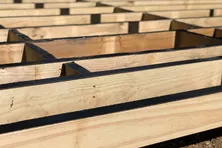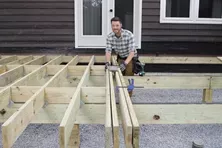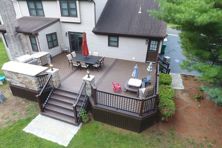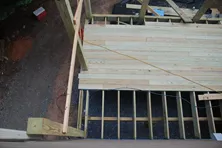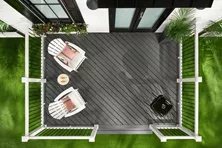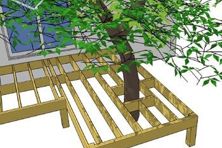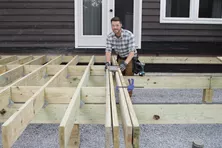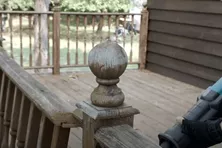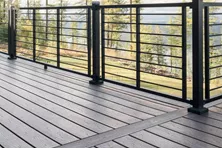Decks vs Patios: Cost, Pros, Cons, & Comparisons
Outside living spaces like decks and patios offer a wealth of opportunities for entertaining. From grilling out with family and friends to simply unwinding after work, a patio or deck can create the right atmosphere for many happy memories.
But before you take the plunge on planning an outdoor living space that works for your lifestyle, you might have questions. Is it cheaper to build a deck or a patio? (Hint: a patio is usually cheaper though a deck is a better return on investment.) Which is easier to build? Should you build a deck attached to your home or a free-standing patio? There are many options when it comes to building outdoor living spaces and it can be tough to weigh the pros and cons.
- Differences Between Decks & Patios
- Paving vs Decking Cost
- Pros and Cons of Patios and Decks
- What’s the ROI for a Deck vs. Patio?
Differences Between Decks & Patios
The primary differences between decks and patios include the way they’re designed, their location at your home, and the building materials used. While both provide you with valuable outdoor living space, there are factors to consider, such as wood vs. concrete and ground-level vs. raised. Understanding the differences between decks and patios can help you make an informed decision about which is right for you. You’ll want to consider the costs, location, the terrain, and your own personal tastes.
Beyond the differences between decks and patios, there are different subcategories for each. Compare them to see which is right for you.
What is a Deck?
Decks are raised platforms made of a variety of materials, including wood, pressure-treated lumber, composite, PVC, and more. Usually, a deck is attached to the home. They can sit high above the ground and be accessed via a staircase or be built low to the ground and raised only by joists.
Two Types of Decks
While an elevated deck may be what comes to mind for many, it’s possible to also have a deck at ground level. This type of deck is different from a patio because a patio sits directly on the ground while the deck does not.
- Elevated Deck - In many neighborhoods, elevated decks extend from the living and dining areas of the main floor. Because they’re elevated, they work well on sloping lots and other uneven ground, which makes them ideal for raised homes or hilly areas.
- Ground-Level Deck - Despite the name, a ground-level deck is not completely level with the ground. While these decks are low to the ground, they still require a slightly raised substructure. Ground-level decks often have a few stairs for guests to comfortably access the deck. Additionally, a ground-level deck requires less maintenance than an elevated deck and does not have to be attached to the house in order to be a stable structure.
What is a Patio?
Patios are outdoor seating areas that are flush with the ground and often made of concrete. (Although concrete is considered the most popular building material for a patio, you may also choose stone, gravel, and other materials for a patio.
One of the most important considerations for those weighing installing a patio or deck is whether or not your ground is level. Since patios sit on the ground, a patio needs to sit on a flat surface. Alternatively, you can shore up the ground so it’ll be flat.
Decking vs. Cement Patio Cost
The costs of decking vs paving are difficult to weigh because there are several material options to consider. But including all necessary substructures and fasteners, the average cost of decking is about $9 per square foot. The pricing of paving with brick is about $6 per square foot, while paving with concrete is closer to $4 per square foot. You can double these estimates to help approximate the cost of labor. Making your patio a DIY project can help you save even more on your patio.
Composite Deck vs Pavers
The cost of composite deck vs pavers will depend on the quality of the material. You can find high quality composites anywhere between $5 and $13 per square foot. A simple brick paver patio will cost around $5 per square foot, while stamped concrete with ornate designs will cost closer to $12 per square foot.
The lifetime costs of a composite deck vs paver patio are roughly the same. Apart from intermittently hosing them down or replacing the occasional broken paver, both require minimal maintenance.
Wood Deck vs Pavers
Similar to the cost of a composite deck vs patio, the average cost of a pressure-treated lumber deck is about $6 per square foot. That makes the cost of a wood deck vs pavers patio fairly comparable, at least initially. Because wood requires routine maintenance to slow down its natural decay, like sanding and resealing. By contrast, the lifetime cost of a pavers patio is almost the same as the sticker price.
Is it cheaper to build a deck or concrete patio?
It’s cheaper to build a concrete patio in terms of both the initial cost to lay a concrete patio, as well as its cost of maintenance over time. A concrete patio costs only $4 per square foot, while a deck costs roughly $6 per square foot for lower-cost pressure treated lumber. Typically, a patio is just a single slab, while a deck can be a simple, elevated one-level deck or have a more elaborate, multi-level construction. The more elaborate your deck, the more expensive it will be. If you’re looking for a cost-effective solution for a small space, a concrete patio may be your best bet.
Pros and Cons of Patios and Decks
One of the most common questions in the debate between patios and decks is the cost. However, there’s more to building an outside entertaining space than cost. You’ll also want to consider factors like the time involved to build, whether you’ll need a permit, the return on investment, and your lifestyle. Here are a few decks vs. patios pros and cons to mull over before you commit to building a gorgeous outdoor living space that works with your wants, needs, and aesthetics.
| Considerations | Deck | Patio | Pros & Cons |
|---|---|---|---|
| Cost | $25 - $43 per square foot | $5-$15 per square foot | Patios are cheaper to build, partially because the building materials are cheaper and because they’re installed flush with the ground, requiring less materials and labor to create stairs, install joists, railings, and other components associated with decks. However, decks average a 76% ROI compared to indoor home renovations and the installation of a patio. |
| Time to Build | May require permits | May require significant ground prep | Most areas require building permits prior to building a deck, which can add waiting time before you can start building. Although a permit is not always required to build a patio, it’s best to check with your local building office to confirm it is not needed. Even if you do not need a permit, however, a concrete patio may require significant preparation of the ground prior to pouring the concrete. |
| Lifestyle Considerations | Better views; requires railings, which can add to cost | More Privacy | Because decks tend to be higher, you get a better view from an elevated height. However, due to their elevation, building and safety codes require railings for elevated decks. These features are one of the most expensive components of an elevated deck. On the flipside, patios -- particularly enclosed patios with screening -- are lower to the ground and can offer a greater sense of privacy. |
| Maintenance | More maintenance than a patio, although level of maintenance varies depending upon material | Easy maintenance | Patios made of concrete pavers are durable and long-lasting. However, you’ll need to treat the soil beneath your patio to prevent cracking in cold weather. Wooden decks require power washing, repainting, and sealing every couple of years. Choosing a wood composite for your deck can help protect it longer and drastically reduce the amount of time spent on yearly deck maintenance. |
| Terrain Considerations | Any terrain | Flat terrain | Patios are suitable for flat areas. Raised decks work well on sloping or uneven ground. |
| Lifespan | Wood deck (10-20 years) Composite deck (25-30+ years) | 25-30+ years | Patios can last for decades if they’re well-maintained. They do need to be cleaned frequently of leaves and other debris to keep them a clean, attractive place to enjoy time outdoors. Composite decks, if well-maintained, can last just as long as a patio. Wooden decks are less weather-resistant than composite decks, giving them a shorter lifespan. However, regular washing, treating, and maintenance can extend the lifespan of a wooden deck. |
| Attached | Yes | Maybe | Attached decks offer an extension of the existing interior living space. Patios don’t have to be attached to the house. |
While both patios and decks are open air living spaces, that’s where the similarities end and the vast array of differences begin. The patio is on the ground, long-lasting, and offers privacy. The elevated deck soars in the air and offers a view.
If you’re trying to decide on a deck vs. patio, consider the terrain, your budget, and your preferences. When it comes to costs, patios are often cheaper and easier to build but depending on the location, a deck may be a more valuable upgrade to your outdoor living space.
What’s the ROI for a Deck vs. Patio?
If you think you may sell your home in the next few years, you’ll want to consider the return on investment (ROI) for a patio vs. deck. Obviously, your choice in building materials will contribute to the costs. For example, choosing flagstone for a patio is more expensive than plain concrete. However, flagstone delivers a much more upscale, bespoke vibe compared to concrete, which can significantly boost your home’s curb appeal -- and market resale value.
Resources like Remodeling Magazine and HouseLogic show the ROI for a deck to be roughly 75% more than for a patio. As an example, a deck that costs $9,000 to build, maybe worth an additional $7,500 when you sell vs. a patio that may cost $3,500 to build and is only worth $1,500 when you sell.
Now that you have a better understanding of the pros and cons of patios and decks, you have a firm foundation to build on to plan for an outdoor living space you can enjoy and a potential investment in your home that may prove profitable when it’s time to sell. Have more questions? Contact a builder to determine which one is right for you.
How to Decorate Deck Support Columns
Browse some examples of decorative deck support posts for tall decks.
Why is Joist Protection so Important for Your Deck?
If you’ve ever seen a piece of wood left out in the weather for any period of time, you know what happens: decay. Whether through wet rot, insect damage, or mildew, the fibers begin to break down.
Deck Blocking: Bridging, Spacing, Methods, and How to Install Like a Pro
Learn the importance of deck blocking and how to install it when building your deck.
Decking Patterns
Installing your decking at a 45-degree angle is a popular style for decks. This can be done to reduce decking seams or just for appearance.
Best Time to Build a Deck
People often wonder when the best time to build a deck is. Learn why building a deck in winter or fall might be your best bet.
More Helpful Resources
Explore Articles by Topic

Footings
Information related to installing frost footings for decks

Framing
Learn structural framing methods

Decking
Learn about wood and composite decking materials

Stairs
An in-depth look at the complex issue of how to build stairs

Railings
How to install guardrails and handrails to meet IRC code

Features
An overview on water drainage, benches, planters and lights

Design
The basics of deck design

Planning
Learn about permits and working with contractors

Porches & Patios
Build a covered deck to enjoy all seasons

Ledger
Proper attachment techniques

Care
Maintain your deck to maintain your investment

Materials
An overview on water drainage, benches, planters and lights
Why is Joist Protection so Important for Your Deck?
If you’ve ever seen a piece of wood left out in the weather for any period of time, you know what happens: decay. Whether through wet rot, insect damage, or mildew, the fibers begin to break down.
Building a Deck Around a Tree
Learn how to build a deck around a tree to allow the tree to grow and not damage its root system while digging footings.
How to Sister Deck Joists
Learn about how to sister deck joists over a beam for framing a large deck or adding onto an existing deck.
How to Demolish & Remove a Deck
At some point, it might become necessary to remove an old deck, due to age or condition. Learn more about what's involved in a deck demolition and removal project.
6 Best Alternatives to Wooden Decking
While wood decking was previously considered the standard material for building a deck, that’s changed. Homeowners have been exploring and embracing different types of materials, and the availability of alternative decking materials has grown significantly.
Decking Patterns
Installing your decking at a 45-degree angle is a popular style for decks. This can be done to reduce decking seams or just for appearance.
Explore Articles by Topic

Footings
Information related to installing frost footings for decks

Framing
Learn structural framing methods

Decking
Learn about wood and composite decking materials

Stairs
An in-depth look at the complex issue of how to build stairs

Railings
How to install guardrails and handrails to meet IRC code

Features
An overview on water drainage, benches, planters and lights

Design
The basics of deck design

Planning
Learn about permits and working with contractors

Porches & Patios
Build a covered deck to enjoy all seasons

Ledger
Proper attachment techniques

Care
Maintain your deck to maintain your investment

Materials
An overview on water drainage, benches, planters and lights




